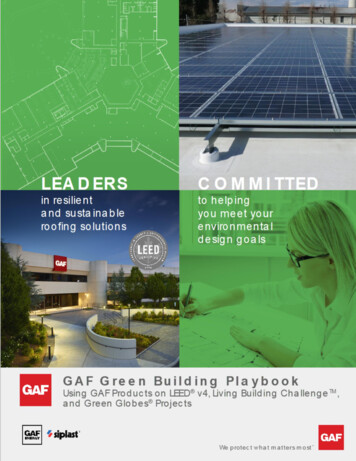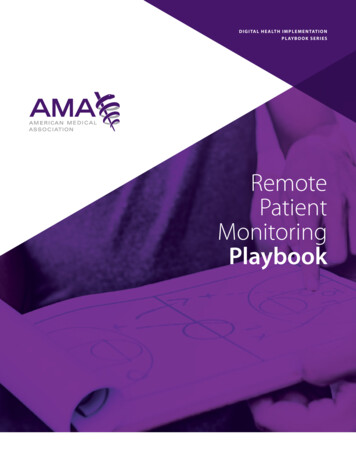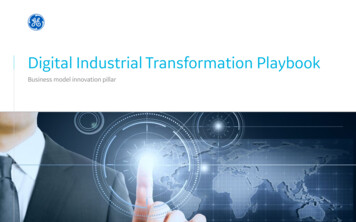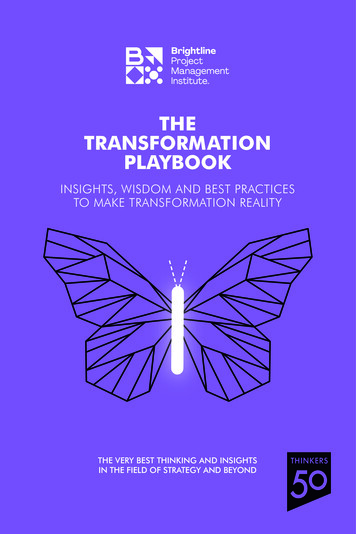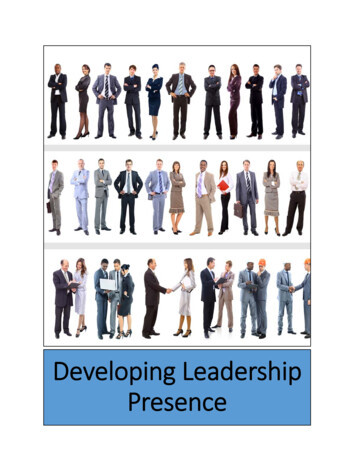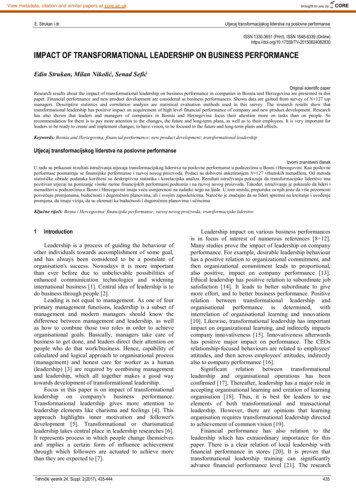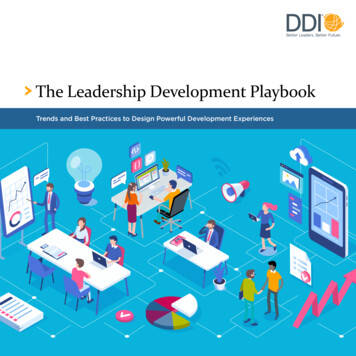
Transcription
The Leadership Development PlaybookTrends and Best Practices to Design Powerful Development Experiences Development Dimensions International, Inc., 2020. All rights reserved.1www.ddiworld.com
Table of ContentsThe Disruptive Leadership Development Landscape.4What’s Getting in the Way?. 8A New View: Leadership Development By Your Side.11Leadership Development Redesigned: 5 Best Practices. 15What’s Next?. 37 Development Dimensions International, Inc., 2020. All rights reserved.2www.ddiworld.com
The Big Question: What Really Works?Who drove your digital transformation: Your CTO, yourused here repeatedly—and to provide food for thoughtCIO, or COVID?as you juggle multiple leadership development prioritiesIt's a joke we’ve often seen shared as a response to theand seek to answer the Big Questions facing all resourcestrapped HR and talent functions: What should we dopandemic. At heart, it’s a testament to how much weworry about change, but when forced, we’re surprisednext? What will work today and in the future?by how adaptable we really are.This guide includes a review of the current leadershipFor decades, we’ve been talking about digitaldevelopment landscape, research-backed trends thatpoint toward its future, a case for change, and besttransformation, including in the leadership developmentpractices drawn from DDI’s 50 years of innovationindustry. We’ve wondered how to create the rightand experience working by the side of organizationsblend of digital learning with the human touch ofin-person interactions, and carefully tweaked approachesaround the world.over time.The right answer, of course, depends on the context ofBut when the pandemic hit, leadership developmentyour organization, your situation, and your goals. Thisplaybook has insights and options to help you designprofessionals were forced to make a tough choice: gopowerful development experiences so you can buildall-virtual or do nothing at all. And “nothing at all”better leaders for a better future.became the worst choice to make as organizationsrelied more heavily on strong leadership to get themon great leadership development design that meets“To meet this challenge, companies should craft a talentstrategy that develops employees’ critical digital andcognitive capabilities, their social and emotional skills,and their adaptability and resilience. Now is the time forcompanies to double down on their learning budgets andcommit to reskilling. Developing this muscle will alsostrengthen companies for future disruptions.”your context.McKinsey, “To Emerge Stronger from the COVID-19 Crisis,In this playbook, we aim to place the current state ofCompanies Should Start Reskilling Their Workforces Now,”through the crisis.As we look to the future, there’s no question that it willbe more virtual. But it won’t always be an all-or-nothingchoice. And it doesn’t mean learning should lose thehuman element. Rather, we need to rely more than everMay 2020leadership development in context—a word you’ll see Development Dimensions International, Inc., 2020. All rights reserved.3www.ddiworld.com
The Disruptive Leadership DevelopmentLandscapeA profound shift in the human experience at work.We are at a profoundly pivotal moment in the history ofComing in at #5 on their list was what most assumedleadership and leadership development. Why? Becausewould be at the top: generating long-term value forwe’re in the middle of a radical transformation of theshareholders.human experience at work.While this statement caught the attention of manyFirst and foremost, the pandemic has forced a shift toobservers, it didn’t come as a complete shock. Afterremote work in many companies. As a result, leadersall, this reordering of priorities reflects the culminationare struggling to connect with their teams more thanof trends that have been building for some time. In aever, especially when there’s a lot of change andworld that’s highly transparent, people want to knowemotional upheaval.the companies they buy from, partner with, and workSecond, there’s been a deep change in the role offor are positively impacting the community.purpose in business. It has always been a fundamentalThis sense of ethics and community purpose has beentruth that the purpose of business is to make money,called into question even more during the social unrestparticularly for shareholders. Yet in late 2019, theduring 2020. Organizations are expected to do goodBusiness Roundtable, an association of CEOs fromin the world, and value diversity and inclusion for all200 of America's most prominent companies, declaredemployees.that the fundamental purpose of business is to:And that creates a major shift for leadership1. Deliver value to customersdevelopment.2. Invest in their employees3. Deal fairly and ethically with suppliers, and4. Support the communities in which they work Development Dimensions International, Inc., 2020. All rights reserved.4www.ddiworld.com
New Demands on Leadership DevelopmentNo surprise, these trends are having a deep impact onleadership development. Today's corporate leaders areAnd it's critical that every company begin to re-evaluatenot only which skills are most necessary, but how theycan develop these skills in their leaders.called on to do more than manage work. They need toDoing so will require organizations to navigate a growingbe masters of emotional intelligence, expert coaches,maze of learning and development options and modalities.and engaging motivators. They must help people seeBut it also requires an understanding of the state ofthe purpose in their work and show them clear pathsmodern leadership.for growth. All while delivering business results.And leaders will be doing all of this while facing a deeplyuncertain future. They will likely be in a near constantstate of crisis management, which creates a new demandfor what were once called “soft skills,” but are now beingviewed as the essential skills of leadership.“History never looks like history whenyou are living through it.”John W. Gardner Development Dimensions International, Inc., 2020. All rights reserved.5www.ddiworld.com
Leadership: It’s Never Been Tougher!Leaders feel the impact of rapid change.Need proof? Consider these four major forces of change:1. Work: Radically CompressedEverything is being compressed: shorter work cycles, more complexity, experimentation, and rapiddecision-making. Business decisions that were once the domain of senior leaders are being pushedfurther down the organization, putting more pressure on leaders at all levels to make decisions thatcan have significant consequences for a business.2. Structures: Networked, Virtual TeamsIn more team-based, flat, networked organizations the ability to get things done through othersrequires a very different approach to traditional structures based on position power and authority.And as more of these teams work remotely, the ability to connect and influence virtually hasbecome even more important.3. People: Craving Impact and PurposeEmployee expectations have changed dramatically. Employees want to know they are makinga worthwhile contribution to the organization and society at large, they want work that isinteresting and meaningful, and they are constantly looking for growth and opportunity. Andthey are looking for connection with their peers as they switch to remote teams.4. Leaders: Constant TransitionLeaders themselves are in a constant state of transition, dealing with increasing uncertaintyand ambiguity. As a result, what was once called “change leadership” is now simply leadership.Furthermore, many of them are doing it from a distance. Development Dimensions International, Inc., 2020. All rights reserved.6www.ddiworld.com
The forces of change are bearing down on leaders. What’s making it more challenging?Leadership transitions are tough.DDI’s research has shown that a leadership transition1 is among life’s most challenging adjustments, ranking upthere with personal illness or a major life event. And given the pressures facing leaders now, these transitions aregetting harder, not easier. Leaders aren’t prepared.Just one in three leaders feels they are effective at handling the challenges associated with a new leadershiprole. Only 40 percent of executives feel the development they receive is high quality2. Additionally, 60 percentof frontline leaders say they have never received any training or preparation for the role and two-thirds offrontline leaders felt unprepared for the role3. As a result, 87 percent of first-time leaders feel frustrated, anxiousand uncertain about their role and at least half of executive transitions fail4.60% of frontline leaders say they have neverreceived any training or preparation for aleadership role.DDI, Leaders in Transition, 2015.DDI, The Conference Board, and EYGM Limited. Global Leadership Forecast, 2018.3DDI, The Frontline Leader Project. 2019.4Harvard Business Review. 2017.12 Development Dimensions International, Inc., 2020. All rights reserved.7www.ddiworld.com
What’s Standing in the Way?Research by Harvard Business Review5 and LinkedIn Learning6found that time is the number one obstacle to leadershipdevelopment. Time creates pressure, and pressure leads usto make some less-than-ideal choices about how we approachlearning and leadership development.Unfortunately, these choices are driving some undesirable trends:Relying on “old faithful.”Rather than investing in the next generation of leaders orenhancing the skills of current leaders, we default to the usualsuspects: those who we know can get things done. While thismay deliver short-term benefits and results, it does little tostrengthen the overall leadership pipeline.Taking a “build it and they will come” approach.Many organizations make online learning curricula and otherself-directed resources available to leaders, and assume their workis done. While self-directed learning is and should be a part ofan organization’s approach to leadership development, not alldevelopment should be self-directed. Leaving leadership developmentto individual curiosity and chance is a high-risk approach (i.e., it oftendoesn’t work). It’s not hard to understand why as DDI researchconfirms, learners are in fact looking for less self-directed learning7.Adopting a “sink or swim” strategy.Not a new mistake, but the now-constant pressure of time makesThe biggest barrier todeveloping leaders? Time.it tempting to allow “natural selection” to take its course. However,HBR, The State of Leadership Development, 2018LinkedIn, LinkedIn Learning Report, 20197DDI, The Conference Board, and EYGM Limited. Global Leadership Forecast, 2018.56 Development Dimensions International, Inc., 2020. All rights reserved.8www.ddiworld.com
the debate about leaders being born or made is over;time spent on all activities, including training. However,leadership is developed over time. While some peoplewe need to constantly ask ourselves if these “moremay bring qualities and attributes that predispose themefficient” approaches really deliver the outcomes weto be effective in certain situations, leadership—andare looking for.leadership development—requires focus and practice.Overvaluing the role technology can play.The evidence is there to support formal developmentDespite the immense attention and investment it attracts,particularly with key leadership transitions. Companieslearning technology isn’t having a notable impact onthat have transition programs and prepare their leadersleadership or business outcomes,9 nor is technologyto step up, are more than two times more likely to besurpassing high-touch methods such as formal learningin the top 20 percent of organizations in their financialand development assignments. The appropriate use ofperformance.8technology has the potential to significantly enhance the Employing a one-and-done program.learning and leadership development experience, but itSome organizations simply invest in a single event ormay not always be the best option.short program for their leaders. While a one-and-done Shortsightedly ditching the classroom.approach satisfies the need to do something it ignoresWith more teams working remotely, many companiesthe fact that leadership behaviors and new habits arefeel like they can’t bring people together in the class-developed over time, not in a single moment or event.room. But even if you can’t bring people together inEffective leadership development needs to be constructedperson, it doesn’t mean all classroom training should beas a learning journey that unfolds over time, draws onstopped. In fact, people working remotely are looking formultiple learning options and modalities, and providesmore opportunities than ever to connect and learn inopportunities for skill practice and application.the classroom with other leaders. Rather than ditch theCompressing learning to save time.classroom in favor of all self-driven learning, companiesThis growing trend builds on the previous point aboutcan look to virtual classrooms to keep the connectiondevelopment as a journey. With the pressure of time,between leaders.companies are legitimately looking for ways to reduce89DDI, The Conference Board, and EYGM Limited. Global Leadership Forecast, 2018.DDI, The Conference Board, and EYGM Limited. Global Leadership Forecast, 2018. Development Dimensions International, Inc., 2020. All rights reserved.9www.ddiworld.com
AskSmall,for specificyet pen everyactuallydaydid—notdefine whata leader’sthey performancetheoretically wouldand impact.do. Development Dimensions International, Inc., 2020. All rights reserved.10www.ddiworld.com
A New View: Leadership DevelopmentBy Your SideLeadership is a human endeavor inevitably filled withThe argument could be made that these momentschallenges, triumphs, and failures. Behind every leadershipare not only where leadership happens, but they arerole is a person trying to do their best in an environmentleadership. Those responsible for leadership developmentof changing expectations and uncertainty.need to understand this and seek to adopt a moreOrganizations need to focus on supporting leadershuman-centered approach that recognizes the challengesof leadership and puts the leader at the center ofthrough their critical leadership moments—what DDIrefers to as “by your side” leadership development.development experiences.These critical leadership moments can be the large,While this sounds both noble and logical, it’s easiertransformative moments such as making a transition intosaid than done.a new leadership role or aligning the skills and capabilitiesof leaders with an organization’s strategic and culturalpriorities. They can also be the small, yet profound,moments that happen every day and define a leader’sperformance and impact. These moments include havinga performance conversation, making a critical selectiondecision, or setting up a new team. Development Dimensions International, Inc., 2020. All rights reserved.11www.ddiworld.com
Make Every Moment of Leadership CountIf time is the biggest obstacle to developing leaders,The second horizon is 480 days.how do we change our relationship with time? How doThis number of work days represents a two-yearwe make a meaningful investment of the time we haveperiod and for most companies is the horizon of criticaland develop leaders for their most critical leadershipbusiness priorities. In 480 days, leaders are often askedmoments?to drive priorities such as innovation, transformation,At DDI, we developed a framework to think aboutor operational performance. But too often, companiesdon’t prepare leaders for these challenges. As a result,leadership development across three horizons todays slip by without leaders doing the things that willensure that time doesn’t get away from us. We callenable them to step up to the demands of these keythis approach Leadership 480 and it revolves aroundpriorities. Before they know it, they are missing quarterlythe number 480.and annual goals and targets.The first horizon is 480 minutes.Ask yourself: What are your two-year businessThat’s approximately eight hours or one work day.priorities? Are you preparing your leaders toConsider the moments that leaders have across a dayexecute on them?and the impact that these can have on themselves,their teams, and the organization. For example, thinkThe final horizon is 480 months.about a hallway conversation with a direct report. WhileOr the length of a 40-year career. To fuel their leadershipit might seem insignificant at the time, it can have apipelines, organizations need to be thinking aboutprofound impact on how the direct report feels andtoday, tomorrow, and the future. What are they doingwhat they do. If that hallway conversation goes poorly,to build the longer-term careers and capabilities ofthe team member can feel disengaged, frustrated, orleaders within the organization to ensure a steady floweven angry.of leaders moving through the pipeline? That can meangetting leaders ready for significant career transitions,Ask yourself: How are you preparing leaders toidentifying and developing those with high potential,deal with the critical leadership moments theyand equipping leaders with the skills and insights toface each day? What are the core skills neededmanage their own development and careers.to maximize their impact each minute?Ask yourself: How are you building the longer-termcareers and capabilities of leaders to ensure a steadyflow of leaders moving through the pipeline? Development Dimensions International, Inc., 2020. All rights reserved.12www.ddiworld.com
What are the implications for your organizations Continue initiatives to identify leadership potentialwhen you view time in this way?early, plan for future leadership needs, and provide P repare your leaders to make the most of theiropportunities for growth. Build and maintain a culture480 minutes every day, by helping them developthat promotes growth and engagement so you cana core set of foundational leadership skills (suchretain talented leaders and address their desire toas communicating effectively, coaching, managinghave fulfilling careers.work and performance). Begin with the end in mind. What are the organization’sThe most important implication is that organizationsneed to consider all three horizons concurrently. Focusingshort- and long-term strategic and cultural priorities,exclusively on one at any given time, while neglecting theand what needs to be included in the portfolio of skills,others, may put critical leadership development needsknowledge, experience, and attributes that will setat risk.your leaders up for success. Take a pipeline approach. Your organization’sleadership is only as strong as its weakest link.Applying the Leadership 480 framework andapproach across all levels can strengthen andactivate your leadership pipeline.It’s not about making everything fit in lesstime or waiting until there is a better time.It’s about making a more meaningfulinvestment of the time we have. Development Dimensions International, Inc., 2020. All rights reserved.13www.ddiworld.com
Stop the chaos. Design leadershipdevelopment experiences with purpose. Development Dimensions International, Inc., 2020. All rights reserved.14www.ddiworld.com
Leadership Development RedesignedThe shifts in leadership require new ways of thinking about leadership development and new ways to address them.What follows are DDI’s points of view on the trends and realities of today’s leadership development landscape,and descriptions of the approaches we take to help the organizations we work with address this new reality ofleadership development.DDI's 5 Best Practices1Context Mattersin LeadershipDevelopmentLeaders willhave differentdevelopment needs,depending upontheir logy isn’tchanging the landscapefor leadershipdevelopment. Theexpectations and needsof today’s leaders are. Development Dimensions International, Inc., 2020. All rights reserved.3Variety isthe Spice ofLearningTrying to pick thebest learning methodis like trying to pickthe best ingredientin a recipe.154Don’t LeaveDevelopmentto ChanceThe foundationsare the foundationsfor a reason.5Learn toPerformIt’s less aboutlearning and moreabout performing.www.ddiworld.com
Best Practice Number 1Context Matters in Leadership DevelopmentLeaders will have different development needs, depending upontheir context.Leaders’ learning and development needs aren’tBecause different contexts exist concurrently, you’llsparked by a single definable moment. Instead, manynever be in a position where you can choose one orneeds are dictated by context, as different contexts drivethe other. Rather, you need to build an ecosystem ofdifferent leadership. So, to build effective leadershipleadership development that can support multipledevelopment experiences—much like the differentneeds and deliver the outcomes you need.ways to view time across 480 minutes, days, andmonths—we need to understand the range of microand macro moments that spark a learning orperforming opportunity.An understanding of the context for learning is criticallyimportant and it should shape the type of leadershipdevelopment resources you make available to leaders.For example, accelerating leaders towards futureleadership roles is a business imperative that can’t beleft to chance. It requires putting in place structureddevelopment that prepares leaders for the needs offuture roles and levels. Development Dimensions International, Inc., 2020. All rights reserved.16www.ddiworld.com
What's their context? Why do your leaders need to learn?Just-in-TimeOften leaders need information, knowledge, or guidance at a point in time to do their jobsor complete a task.CuriosityA desire to learn is often sparked by curiosity for a subject matter or area of practice. It may notbe grounded in any specific leadership need, but it often helps to build an individual’s portfolioof knowledge and skills.Self-ImprovementLeaders will often recognize the need to improve their knowledge or skills in an area. Thisis more formal than curiosity and often requires deliberate focus and practice. The drive forself-improvement is typically underpinned by a specific need to enhance certain skills or buildone’s knowledge and understanding of a subject.Advance to New Role or LevelLeaders and organizations recognize the need to develop new skills and acquire new knowledgeas people advance or move to a new role or level. This is based on the simple reality that the skillsand knowledge at one level of the organization may be very different to those at another level.Prepare For A Specific Business ChallengeLeaders must often pivot toward a specific company business challenge or priority. This maydemand new skills or perspectives.Prepare For Future Role or LevelLeaders and organizations will often forecast the need for a set of skills and knowledge thatwill be important in future roles and levels. For example, leaders recognize the need early in aleadership journey to develop their approach to strategic thinking. Development Dimensions International, Inc., 2020. All rights reserved.17www.ddiworld.com
Leaders are looking for leadership developmenttailored to their specific needs and context. Development Dimensions International, Inc., 2020. All rights reserved.18www.ddiworld.com
Best Practice Number 2Design “Leader-First” ExperiencesTechnology isn’t changing the landscape for leadership development.The expectations and needs of today’s leaders are.The traditional approach to education and learningDDI has adopted several design principles that ensurehas been based on the premise that the teacher knowsthe leader and the leader’s needs are at the center ofbest. This has contributed to learning environmentsour approach to building effective, high-impact leader-defined by a one-size-fits-all approach. Today, thisship development solutions. Together these principlesmodel is no longer relevant. Leaders are far morecontribute to a leadership development experienceaware of their needs and are looking for leadershipthat is deeply relevant, connected to the context ofdevelopment solutions tailored to their specific needsthe organization, and integrates a more personalizedand context.perspective of skills and application.Organizations must find ways to personalize theAs you design leader-first experiences, considerleadership development experience. The key is toour core design principles:ensure they understand the specific needs of their Relevance: Connect to the challenges of the leadersleaders and build solutions that speak to thoseneeds. This means putting the learner or leader atthe center of the development experience. Methodssuch as human-centered design can inform boththe approach and the toolkit used by leadershipdevelopment practitioners.in your organization’s context. Personalization: Highlight the unique value toindividual leaders. Immersive: Learn by doing and experiencingthe challenge. Human: Engage the heart and make it authentic. Trusted: Ensure that the time leaders invest is inexperiences that really work and are aligned withthe company’s values. Development Dimensions International, Inc., 2020. All rights reserved.19www.ddiworld.com
Development Designed for LeadersCore design principlesRelevanceToo often leaders are presented with frameworks andsituations they don’t see as immediately relevant tothe challenges they face. Learning must address realsituations and challenge leaders, and it needs tohappen quickly to ensure leaders are engaged. They’realso seeking a connection to the purpose of theorganization and, therefore, want to see how theirlearning and leadership development efforts connectthem to the values, strategic priorities, and broaderbusiness purpose. Our approach to building relevantleadership development programs draws on a numberof simple but profound design elements including:Bringing in the Organization CultureFind ways to incorporate the leader’s current situationby tying the concepts to the company values or currentinitiatives. Ask leaders, “Does this work at ourorganization? If not, why?”Leveraging Learner ScenariosWhen introducing a topic, ask leaders to provideexamples or scenarios that are relevant for them.Canned examples can work but give them the optionto suggest others. Make sure exercises don’t precludethe ability to customize to the learner’s scenarios.10Asking About Learner NeedsAlways ask learners what challenges they face mostoften. Where do they need help the most?PersonalizationWhen leaders have a limited amount of time, it becomesmuch more important that every minute spent learningis meaningful. A personalized experience helps to dothat and enables leaders to understand and applyconcepts more quickly.Personalization is the most dominant feature definingwhat leaders want most from their learning anddevelopment experience10. Personalized learning cantake many forms, from allowing leaders to choosetheir own learning path, to linking individual goals todevelopment plans, or providing leaders with relevantcontent and tools.DDI believes that personalized leadership developmentrecognizes the leader’s uniqueness but stays groundedin the context of the business. Deep personalization isdriven by data and insight, which DDI gathers throughdiagnostics and self-insight tools. For example, beforeembarking on a development journey, leaders mightparticipate in an immersive assessment center toDDI, The Conference Board, and EYGM Limited. Global Leadership Forecast, 2018. Development Dimensions International, Inc., 2020. All rights reserved.20www.ddiworld.com
ensure they enter the program with a clear understandingTechnology alone isn’t enough—but addsof their strengths and development priorities in relation tovalue when it’s relevant and personalized.the areas to be covered.It’s not about implementing technology for its ownsake, particularly not to enable the self-study formsof learning libraries that many leaders shun (and don’treally have time for!). When technology is designed andimplemented to match a specific need or program, itcan generate value for on-demand learning. Technologyworks best when giving “always on” leaders thetools and access they need to grow themselves anddevelop others.Technologies like artificial intelligence (AI) and machinelearning are creating opportunities for the kind of personalization that in the past has been extremely difficult. AIcan not only react to individual differences and needs, itcan start to anticipate and predict leader needs that aredeeply personalized.ImmersiveImmersive learning is learning by doing. Learners becomeactive participants in the learning process by directlyengaging with situations and challenges they can relateto. While the pedagogic value of immersive learning isstrong, it also contributes to learning that is absorbing andsatisfying. This is important in a world where leaders areconstantly exposed to a full range of engaging experiencesoutside of the learning realm.Emerging technologies like virtual reality can create uniqueand memorable immersive experiences. DDI is quicklyDDI’s digital platform Pinpoint is designed for you tocurate what your leaders need most: focus on the mostrelevant leadership skills and alignment to the broaderbusiness context. With Pinpoint, time-strapped leaderscan have a personalized experience with the rightcontent and reinforcement tools aligned to yourleadership development program. Leaders can alsocreate per
self-directed resources available to leaders, and assume their work is done. While self-directed learning is and should be a part of an organization’s approach to leadership development, not all development should be self-directed. Leaving leadership development to individual cur


